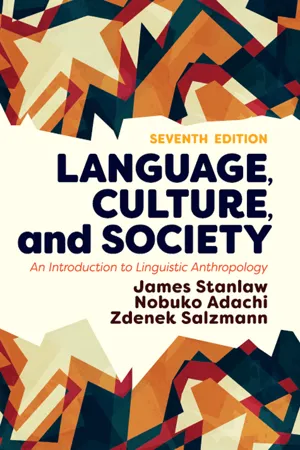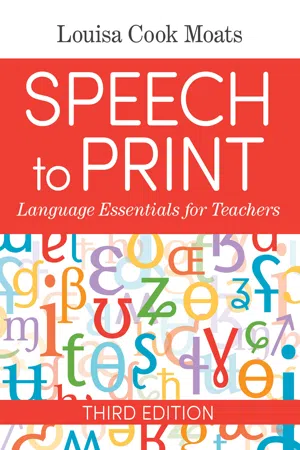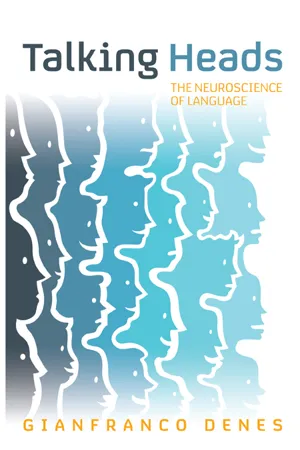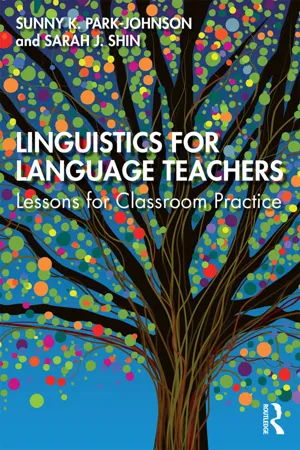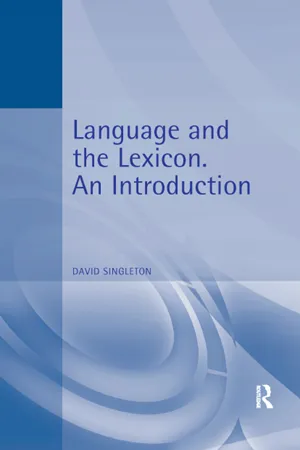Grammatical Morphemes
Grammatical morphemes are the smallest units of language that carry grammatical meaning. They include prefixes, suffixes, and infixes, and are used to indicate tense, number, gender, and other grammatical features. In English, examples of grammatical morphemes include the -s for plural nouns and the -ed for past tense verbs.
6 Key excerpts on "Grammatical Morphemes"
- eBook - ePub
Language, Culture, and Society
An Introduction to Linguistic Anthropology
- James Stanlaw, Nobuko Adachi, Zdenek Salzmann(Authors)
- 2018(Publication Date)
- Routledge(Publisher)
...The principal unit of morphology is the morpheme, the smallest meaningful part of language. There are thousands of morphemes in any language: Those that may be used by themselves are termed free; those that occur only attached to other morphemes are termed bound. Many morphemes have more than one phonemic shape; the variant forms of a morpheme are its allomorphs. Grammar—the various rules that govern the workings of a language and the processes that implement these rules—varies from one language to the next. Some languages are characterized by many inflectional forms (for example, Latin), others by relatively few (for example, English). The complexity of grammar, however, does not add to the prestige of a language. The study of the phonemic differences among allomorphs of the same morpheme is referred to as morphophonemics. The plural morpheme of English nouns has a variety of allomorphs; one may therefore speak of the morphophonemic rules of English noun pluralization. Sentences are the largest structural units of a language, and their study in the traditional conception is called syntax. In transformational-generative grammar, syntax refers not only to sentence structure but to word structure as well. In this approach, the syntactic component is one of three major organizational units of a grammar, the others being the phonological and the semantic components. Having to do with the structure of meaning, the semantic component has been the last to be studied in modern linguistics and the one worked out in least detail. Photo 4.1 Gary Witherspoon and his wife, Nellie, at their Navaho wedding. Courtesy of Gary Witherspoon. The interest of structuralists and descriptivists in linguistic variety the world over has long been shared by linguistic anthropologists, many of whom deal with unwritten languages of little-known peoples...
- eBook - ePub
Speech to Print
Language Essentials for Teachers
- Louisa Cook Moats(Author)
- 2020(Publication Date)
- Brookes Publishing(Publisher)
...They can be categorized by their language of origin and by their grammatical role. Classes of Morphemes A morpheme is the most elemental unit of grammatical form that has both sound and meaning. Morphos means “form or structure” in Greek; eme means an element or little piece of something. A morpheme may be one or more syllables, as in red, indigo, and crocodile, or a word or a part of a word, as in full, a word, versus - ful, a suffix. Morphemes can be sorted into two basic categories— free and bound (see Figure 5.1). 5 Free morphemes can stand alone as words and do not have to be combined with other morphemes, as in spite, woman, and elephant. Free morphemes may be made up of one or more syllables. Free morphemes, in turn, can be sorted into two broad syntactic categories that determine how we use the words in sentences— function words and content words. Function words are free morphemes and include conjunctions (but), prepositions (below), pronouns (he), auxiliary verbs (was), and articles (a, an). Function words are a closed class of words because languages typically do not add words to these categories, or if they do, the additions or changes occur very slowly. For example, the English language is slow to adopt gender-neutral pronouns, in spite of societal changes in attitudes toward gender identity. Function words are limited in number, learned early, and provide grammatical structure for sentences. Figure 5.1. Classes of morphemes in English. Content words, in contrast, are free morphemes that carry the meaning of a sentence. Content words include nouns, verbs, adjectives, and adverbs. These are by far the largest categories of words in any language. Unlike function words, content words are invented frequently as a language evolves. The meanings of content words also change with time. Thus, content word categories are open, not fixed...
- eBook - ePub
Talking Heads
The Neuroscience of Language
- Gianfranco Denes, Philippa Venturelli Smith(Authors)
- 2012(Publication Date)
- Psychology Press(Publisher)
...This is the formal linguistic representation of the syntactic structure of a sentence, specifying the hierarchy between the various components and their relationship to each other. A sentence, therefore, is represented by the (non-linear) union between various phrases, which make up the building blocks of the syntactic structure of the sentences, combining to form a hierarchical structure. Figure 7.1 A model of the minimalist programme. In order for sentences to be grammatically correct, not only must the elements be placed in the correct order but rules influencing the form of the word within the sentence must also be respected, so that a ‘morphological’ relationship is established between the words forming the sentence. A morpheme is the smallest meaningful element of language that cannot be further divided into smaller meaningful parts. Morphemes can be either free or bound. Free morphemes (articles, prepositions, pronouns, adverbs) carry meaning even when they appear in isolation, while bound morphemes must be connected to other units (lexical morpheme or root) to make up a word. An example of this is the inflectional morphemes added to verbs. If we consider, for example, the words pens or books, we can identify the following morphemes [ pen+s ] and [ book+s ]. The meaning of the root pen- is ‘an object used for writing’, the meaning of book- ‘a collection of printed pages’, while the addition of the morpheme -s lets us know that the words are plural. Pen- and book- are therefore roots or lexical morphemes, while -s is a grammatical morpheme. Morphological processes are divided into inflectional and derivational processes. The first term denotes a process of word formation, the result of the union of two morphemes (usually a root and an inflected morpheme) and the consequent creation of a grammatically complex word. To give an example, verbs are composed of a root and an inflected morpheme...
- eBook - ePub
Linguistics for Language Teachers
Lessons for Classroom Practice
- Sunny Park-Johnson, Sarah J. Shin(Authors)
- 2020(Publication Date)
- Routledge(Publisher)
...This chapter will show how knowledge of the principles of word formation can facilitate students’ learning of new vocabulary and what teachers can do to help students acquire this knowledge. 4.2 Morphemes The most important part of the word is the morpheme, the smallest linguistic unit with a meaning or a grammatical function. Morphemes are important because all languages use them as building blocks to construct words. The word teacher, for example, consists of two morphemes: teach (with the meaning of “give instruction in”) and -er (which indicates that the whole word functions as a noun with the meaning “one who teaches”). Similarly, the word schools is composed of the morphemes school (with the meaning of “an institution where instruction is given”) and -s (with the meaning “more than one”). Some words are made up of a single morpheme. Such words are said to be simple words. For example, the word happy cannot be divided into smaller parts that carry information about its meaning or function. Thus, the word happy consists of a single morpheme. In contrast, the word impersonal is made up of three morphemes, im-person-al. Words that contain two or more morphemes like impersonal are said to be complex words. It is important to not confuse morphemes with syllables. The word happy [hæ.pi] is one morpheme but has two syllables. The word impersonal [ɪm.pʌr.sə.nəl] is composed of three morphemes but has four syllables (note that the “.” in the phonetic transcriptions marks syllable boundaries). Remember that a morpheme is the smallest linguistic unit with a meaning or a grammatical function. Complex words typically consist of a root morpheme and one or more affixes. The root is the primary lexical unit of a word that carries the most significant aspects of semantic content and cannot be reduced into smaller parts...
- eBook - ePub
Language and the Lexicon
An Introduction
- David Singleton(Author)
- 2016(Publication Date)
- Routledge(Publisher)
...These irreducible entities are known as morphemes. In this chapter we shall examine how morphemes function, how they are customarily classified and how they relate to the lexicon. 3.2 Morphemes and allomorphs Morphemes can be defined as the smallest elements of any language which have semantic and/or grammatical significance. As we have seen, some morphemes are also whole words – fish, for example, whereas others are units below the level of the word which nevertheless have their own meaning and/or grammatical function in the context of the words in which they occur, for example - es in fishes, - y in fishy. Morphemes which can stand alone as words are known as free morphemes while morphemes which can only be meaningful or functional as parts of words are known as bound morphemes. Bound morphemes very often manifest themselves as prefixes – elements attached at the beginnings of words (e.g. dis - as in disobey) – or as suffixes – elements attached at the ends of words (e.g. - ize as in idolize). Prefixes and suffixes are known collectively as affixes. Other kinds of affixes to be found in the world’s languages include infixes and circumfixes. Infixes are elements attached within the free morpheme bases of words; for example in Bontoc, a language of the Philippines, the infix - um - makes a verb out of an adjective or noun (thus, fikas – ‘strong’, fumikas ‘to be strong’). Circumfixes are elements which ‘surround’ the relevant base; for instance, in Chickasaw, a Native American language, the negative is formed by the alteration of the base both fore and aft (thus, lakna – ‘it is hot’, iklakno – ‘it is not hot’)...
- eBook - ePub
Applying Linguistics in the Classroom
A Sociocultural Approach
- Aria Razfar, Joseph C. Rumenapp(Authors)
- 2013(Publication Date)
- Routledge(Publisher)
...6 Morphology Building Words with English Learners Learning Goals Summarize the basic concepts of morphology. Identify morphological processes. Understand different types of morphological systems in the world’s languages. Understand the difficulties ELs may have in learning English morphology. Use derivational and inflectional rules in the classroom. Create a case study to analyze a particular topic in morphology. Use morphological concepts in discourse analysis. KEY TERMS/IDEAS: morpheme, lexeme, lexicon, derivation, inflection, agglutinating, fusional, isolating, nominalization In Chapter 5 we discussed the syntax, or grammar of language. Morphology is a related field in linguistics. Sometimes it is very difficult to distinguish what belongs to syntax and what belongs to morphology because there is much overlap. What one language does in syntax, like through changes in word order as seen in the last chapter, another may do through morphology, by changing the word itself. Therefore, it is often better to think about both fields together, as morphosyntax. In Chapter 5, we focused more on how words (in the discrete analytic sense) relate to each other. In this chapter, we will examine how words are built internally to create distinct meaningful units. Morphology is the study of a language’s morphemes and the rules governing its transformations for communicative purposes. Morphemes consist of words, affixes, intonation, stress, and their implied or explicit contexts of use. In this chapter we will see how the traditional concept of “word,” especially in the isolated sense, constrains our view of how we learn, develop, and actually use language to make meaning. As we learn about the ELs in our classrooms, we need to be aware of the complexities of languages in the world. If we look at language only through our “English eyes” we will certainly misunderstand the way language is used by ELs...
